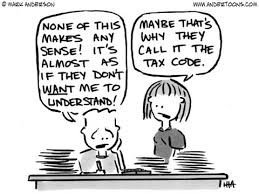 The details of the new 2018 Tax Law have been published. Accountants, attorneys, businessmen, and everyone fearing the worse read them over the past weekend. Yet even though the actual law doesn’t take effect until January 1, 2018 Americans are preparing. So here are a few tidbits to make you moan and groan even more.
The details of the new 2018 Tax Law have been published. Accountants, attorneys, businessmen, and everyone fearing the worse read them over the past weekend. Yet even though the actual law doesn’t take effect until January 1, 2018 Americans are preparing. So here are a few tidbits to make you moan and groan even more.
The British tax laws were instrumental in the American Revolution. Taxation without representation was and still is reprehensible. So it should be no surprise Americans did not pay personal income tax until 1861.
The Revenue Act of 1861 provided for a tax on personal incomes to pay for war expense in the United States. After all, war is expensive. In the South, the Confederate government tax laws covered the property valued at more than $500 (CSA currency) and several luxury items. However, the lack of men to value and collect the taxes caused the Confederate Congress to repeal the tax code and in April 1863 passed a Tax in Kind law. Ten percent of all agricultural products in each state were taken to provision the Army of the Confederacy. This was a fairly successful endeavor except in rural areas such as Texas.
Now back to the North where the Revenue Act of 1861 was as unpopular as the new draft laws. Probably the issue of personal taxes was the only common thread between the two sides. The Revenue Act was repealed in 1871 after cutting the tax in 1867. The next year (1872) the U. S. Supreme Court ruled the law unconstitutional because it was a direct tax, not apportioned according to the population of each state. The 16th Amendment of July 2, 1909 removed that objection allowing the Federal government to tax income without regard to the population of each state. But the 16th Amendment was not ratified until February 3, 1913.
Between 1871 and 1913 Americans paid no personal taxes. For 21st Century Americans, the source of revenue for that time period will be astonishing. Approximately 90% of all U. S. revenue came from taxes on liquor, beer, wine, and tobacco.
With the threat of eminent war with Germany and her allies, as well as the possibility of the national prohibition, Congress believed that an income tax was necessary, especially after the ratification of the 16th Amendment. Four reasons were cited for the new tax law:
- to continue the use of pork barrel or appropriations of government spending for localized spending secured solely to bring money to a representative’s district (custom still in existence)
- to make taxation fairer to all citizens
- to stimulate a sector of the economy
- to raise revenue.
Now comes the tricky part. From 1913 on, American incomes have been bracketed by the amount of taxable income. In the top tax bracket are theoretically the richest persons in the country. It is that top bracket we will now analyze.
In 1913, the top tax bracket paid 7% on all their taxable income over the amount of $500,000 ($11 million in today’s dollars). The lowest bracket paid only 1%.
During World War I Congress passed two tax laws, the 1916 Revenue Act, then the War Revenue Act of 1917 when the U.S. entered the war. The highest tax rate jumped from 15% in 1916 to 67% in 1917 to 77% in 1918.
The 1920s were more prosperous. The top tax bracket dropped to 25% during the 1925 through 1931 period. But once Franklin D. Roosevelt was elected president in 1932 at the onset of the Great Depression, the top tax rate was raised from 25% to 63% for top earners. And what happened after that? World War II brought the top tax brackets up. The top rate peaked at 94% on income over $200,000 ($2.5 million today).
During the 1950s, 1960s, and 1970s the tax rate for top earners remained high, never dropping below 70%. The 1980s brought two new tax laws along with new economic theories. The Economic Recovery Act of 1981 slashed the highest rate from 70% to 50% and indexed brackets to accommodate inflation.
Supporters of the Tax Reform Act of 1986 claimed it was a miracle, a two-tiered tax plan that dropped the top rate to 28% beginning in 1998. It had a broader base to contain few deductions, but brought in the same revenue. Congress vowed to never raise the 28% top tax rate. That lasted three years before the promise was broken.
The broken promise brought in a top tax rate of 39.6% and stayed fairly stable through the 1990s. The Economic Growth and Tax Relief and Reconciliation Act of 2001 dropped the highest rates to 35% for years 2003 to 2010. That year the Tax Relief, Unemployment Insurance Reauthorization, and Job Creation Act maintained the 35% through 2012.
Finally the American Tax Payer Relief Act of 2012 increased the top rate to 39.6%. Patient Protection and Affordable Care Act added additional 3.8% making the maximum tax rate 43.4%.
One last word to remember from the famous Will Rogers who said “the difference between death and taxes is that death doesn’t get worse every time Congress meets.”
Happy New Year!
